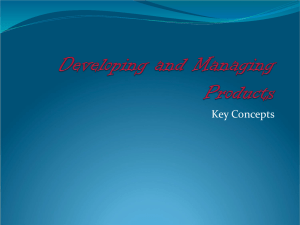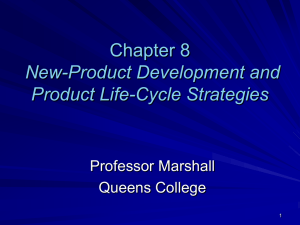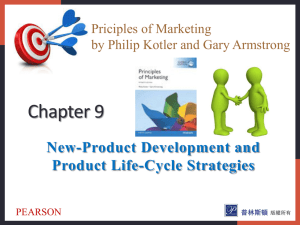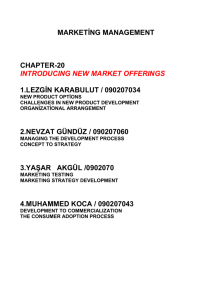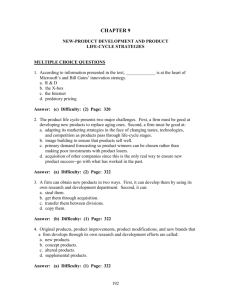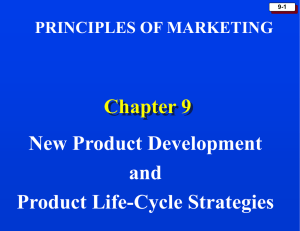Summary of Key Points for Chapter 5
advertisement
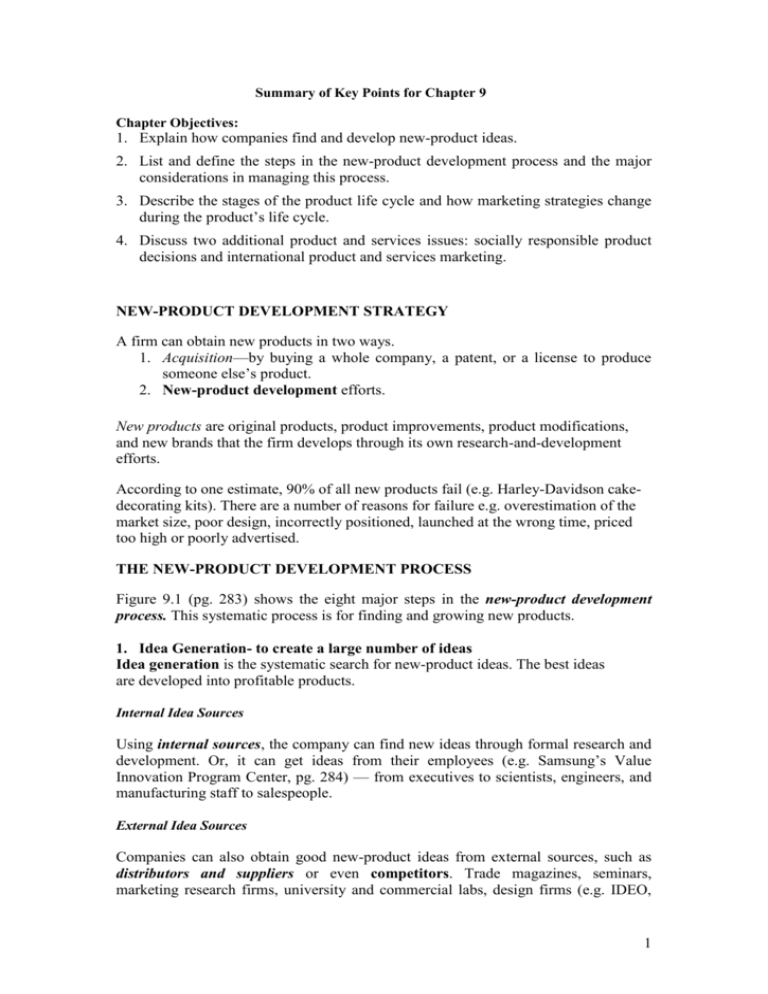
Summary of Key Points for Chapter 9 Chapter Objectives: 1. Explain how companies find and develop new-product ideas. 2. List and define the steps in the new-product development process and the major considerations in managing this process. 3. Describe the stages of the product life cycle and how marketing strategies change during the product’s life cycle. 4. Discuss two additional product and services issues: socially responsible product decisions and international product and services marketing. NEW-PRODUCT DEVELOPMENT STRATEGY A firm can obtain new products in two ways. 1. Acquisition—by buying a whole company, a patent, or a license to produce someone else’s product. 2. New-product development efforts. New products are original products, product improvements, product modifications, and new brands that the firm develops through its own research-and-development efforts. According to one estimate, 90% of all new products fail (e.g. Harley-Davidson cakedecorating kits). There are a number of reasons for failure e.g. overestimation of the market size, poor design, incorrectly positioned, launched at the wrong time, priced too high or poorly advertised. THE NEW-PRODUCT DEVELOPMENT PROCESS Figure 9.1 (pg. 283) shows the eight major steps in the new-product development process. This systematic process is for finding and growing new products. 1. Idea Generation- to create a large number of ideas Idea generation is the systematic search for new-product ideas. The best ideas are developed into profitable products. Internal Idea Sources Using internal sources, the company can find new ideas through formal research and development. Or, it can get ideas from their employees (e.g. Samsung’s Value Innovation Program Center, pg. 284) — from executives to scientists, engineers, and manufacturing staff to salespeople. External Idea Sources Companies can also obtain good new-product ideas from external sources, such as distributors and suppliers or even competitors. Trade magazines, seminars, marketing research firms, university and commercial labs, design firms (e.g. IDEO, 1 ZIBA) and inventors are other external idea sources. Perhaps the most important source of new-product ideas is customers themselves e.g. through online collaborative communities (e.g. Dell - pg 285) and personal interactions with customers (LEGO (pg 285). However, customers may not know what they want or need in terms of highly technical products e.g. innovation in mobile phones, other software and hardware. 2. Idea Screening – to reduce the number of ideas The first idea-reducing stage is idea screening, which helps spot good ideas and drop poor ones as soon as possible. The company only wants to go ahead with ideas that will turn into profitable products. 3. Concept Development and Testing – idea, concept, image A product idea is an idea for a possible product that the company can see itself offering to the market. A product concept is a detailed version of the idea stated in meaningful consumer terms. A product image is the way consumers perceive an actual or potential product. Concept Development In concept development, several descriptions of the product are generated to find out how attractive each concept is to customers. From these concepts, the best one is chosen. Four product concepts for an electric car are described on pg. 287. Concept Testing Concept testing calls for testing new-product concepts with groups of target consumers. Sometimes, a word description or picture is used. At other times the physical representation of the object is shown to consumers, increasing the reliability of the concept test. Refer to Table 9.1 (pg. 287) for examples of questions consumers may be asked about the concept (of a battery-powered electric car). 4. Marketing Strategy Development Marketing strategy development is designing an initial marketing strategy for introducing this car to the market. The marketing strategy statement consists of three parts. 1. A description of the target market; the planned value proposition; and the sales, market share, and profit goals for the first few years. 2. Outline of the product’s planned price, distribution, and marketing budget for the first year. 3. Description of the planned long-run sales, profit goals, and marketing mix strategy. 2 5. Business Analysis Business analysis involves a review of the sales (review the sales history of similar products and conduct market surveys), costs (e.g. marketing, R&D, operations, finance and other costs), and profit projections for a new product to find out whether they satisfy the company’s objectives. If they do, the product can move to the product development stage. 6. Product Development In product development, R&D or engineering develops the product concept into a physical product. The product development step calls for a large jump in investment. Often, products undergo rigorous tests to make sure they perform safely and effectively (e.g. Louis Vuitton, Gillette –pg. 288, pg 289). The new product must have the required functional features and the intended psychological characteristics (e.g. comfortable, safe for a car; beautiful and special for a handbag). 7. Test Marketing Test marketing is the stage at which the product and marketing program are introduced into realistic market settings (e.g. KFC test-marketed its new Kentucky Grilled Chicken product for 3 years, before rolling it out widely- pg 289). It tests the product and its entire marketing program– targeting and positioning strategy, advertising, distribution, pricing, branding, packaging and budgeting. But, companies often do not test-market simple line extensions or when management is already confident about the new product. Drawbacks/disadvantages include: 1. Costly 2. Time consuming 3. Competitors can monitor results 4. Competitors get an early look at your new product. Test marketing also does not guarantee success. When using test marketing, consumer products companies usually choose one of the following approaches: standardized test markets, controlled test markets and simulated test markets. 8. Commercialization Test marketing gives management the information needed to make a final decision about whether to launch the new product. If management goes ahead with commercialization, it will introduce the new product into the market (e.g. Sunsilk hair care launched by Unilever -pg. 292). Decisions must be made concerning: Timing (e.g. if the economy is down, the company may delay the launch), Where to launch the new product (in a single location, region, country or international market) Market rollout (rollout could be in stages) 3 MANAGING NEW-PRODUCT DEVELOPMENT Companies must manage this process with a customer-centred, team-based and systematic effort. 1. Customer-Centered New-Product Development New-product development must be customer centered. It must not just rely on technical research in R&D labs. Customer-centered new-product development focuses on finding new ways to solve customer problems and create more customer-satisfying experiences. Read Real Marketing 9.1 (pg. 294-295) on IDEO’s customer-centered design process. 2. Team-Based New-Product Development Under the sequential product development approach (Fig 9.1, pg 283), one company department works individually to complete its stage of the process before passing the new product along to the next department and stage. This orderly, step-by-step process can help bring control to complex and risky projects. But it also can be dangerously slow. In order to get their new products to market more quickly, many companies use a team-based new-product development approach. Under this approach, company departments work closely together in cross-functional teams, to save time and increase effectiveness. Instead of passing the new product from department to department, the company assembles a team of people from various departments that stay with the new product from start to finish. It has some limitations. For example, it sometimes creates more organizational tension and confusion than the more orderly sequential approach. But, for rapidly changing industries with increasingly shorter product life cycles, the benefits of faster and flexible product development is greater than the risks. Combining this approach with team-based new prodcut development can get the right products to market faster. 3. Systematic New-Product Development An innovation management system can be used to collect, review, evaluate, and manage new-product ideas, so that new ideas will be encouraged and these ideas will not be lost. It can be web-based and encourage all company stakeholders to be involved in finding and developing new products. The innovation management system approach yields two favorable outcomes. 1. It helps create an innovation-oriented company culture. 2. It will yield a larger number of new-product ideas, among which will be found some especially good ones. PRODUCT LIFE-CYCLE STRATEGIES After the launch of a new product, management wants the product to enjoy a long and profitable life. Figure 9.2 (pg. 297) shows a typical product life cycle (PLC), the course that a product’s sales and profits take over its lifetime. 4 The product life cycle has five distinct stages: 1. Product development begins when the company finds and develops a new-product idea. During product development, sales are zero and the company’s investment costs mount. 2. Introduction is a period of slow sales growth as the product is introduced in the market. Profits are nonexistent in this stage because of the heavy expenses of product introduction. 3. Growth is a period of rapid market acceptance and increasing profits. 4. Maturity is a period of slowdown in sales growth because the product has achieved acceptance by most potential buyers. Profits level off or decline because of increased marketing outlays to defend the product against competition. 5. Decline is the period when sales fall off and profits drop. NOTE: Not all products follow this life cycle. Some products die quickly, others stay in the mature stage for a very long time, some enter the decline stage and are then cycled back into the growth stage through innovation, strong promotion (e.g. Apple) etc. The PLC concept can describe a product class (gasoline-powered automobiles), a product form (SUVs), or a brand (the Ford Escape). Product classes have the longest life cycles. Product forms have the standard PLC shape. Product brand PLC can change quickly because of changing competitive attacks and responses. The PLC can be applied to styles, fashions, and fads (Figure 9.3, pg 298). A style is a basic and distinctive mode of expression. It may last for generations, going in and out of vogue (renewed interest). A fashion is a currently accepted or popular style in a given field. Fashions tend to grow slowly, remain popular for a while and then decline slowly. Fads are temporary periods of unusually high sales driven by consumer enthusiasm and immediate product or brand popularity (e.g. low-carb diets) The PLC concept can be applied by marketers as a useful framework for describing how products and markets work. And, it can help in developing good marketing strategies for different stages of the product life cycle but marketers should not just push products through the traditional stages of the product life-cycle. Strategies for each of the other life-cycle stages Table 9.2, pg. 303 is very useful as a Summary of PLC characteristics, objectives and strategies, from the Introduction stage. Introduction Stage The introduction stage starts when the new product is first launched. In this stage, profits are negative or low, promotion spending is relatively high, only basic versions of the product are produced. 5 Growth Stage The growth stage is where sales begin to climb quickly. New competitors will enter the market. They will introduce new product features, and the market will expand. The increase in competitors leads to an increase in the number of distribution outlets. Prices remain stable. Profits increase during the growth stage. Maturity Stage The maturity stage is characterized by slowing product growth. The slowdown in sales growth results in many producers with many products to sell. Competitors begin marking down prices, increasing their advertising and sales promotions, and upping their product-development budgets to find better versions of the product. These steps lead to a drop in profit. Product managers should consider modifying the market, product, and marketing mix. In modifying the market, the company tries to increase the consumption of the current product. It may look for new users and new market segments (e.g. Gator, pg. 301) and also look for ways to increase usage among current customers (e.g. Glad products, pg. 301-302). In modifying the product, the company tries changing characteristics such as quality, features, style, or packaging to attract new users and to inspire more usage (e.g. Tabasco has been around for 130 years with new flavours and new products, pg 302). In modifying the marketing mix, the company tries changing one or more marketing mix elements. Decline Stage The sales of most product forms and brands eventually dip. This is the decline stage. Management may decide to maintain its brand without change in the hope that competitors will leave the industry. Management may decide to harvest the product, which means reducing various costs (plant and equipment, maintenance, R&D, advertising, sales force) and hoping that sales hold up. If successful, harvesting will increase profits in the short-term. Management may decide to drop the product from the line. It can sell or liquidate it (e.g. some of P&G’s lesser-known or declining brands, pg. 303). NOTE: There will be a QUIZ on Chapters 5, 7, 8 on Saturday, 18 December. 5 multiple-choice and 5 True/False questions (marked over 5%). 6 End-of-Week Questions: 1. Discuss the benefits and drawbacks of test marketing and explain why some companies use or do not use test marketing for new products. Name the three approaches to test marketing. 2. Review the stages of the Product Life Cycle (PLC) contained in Fig 9.2 (pg. 297) and Table 9.2 (p. 303). Answer the following questions: a. What are two products you consider to be in the Decline stage of the PLC? Justify your answer. b. Apple’s iPod seems to be all the rage today. In which stage of the PLC would you place the iPod? Why? c. How do you know when a product has moved from the Growth stage to the Maturity stage of the PLC? 3. Coca-Cola has sustained success in the maturity stage of the product life-cycle for many years. Visit Coca-Cola’s Web site (http://www.thecoca-colacompany.com/heritage/ourheritage.html) and discuss how Coca-Cola has evolved over they years. Identify ways that Coca-Cola can continue to evolve to meet changing consumer needs and wants. 4. Explain the difference between styles, fashions and fads and give an example of each. 5. Read the Company Case on Nintendo (pg. 309- 310). In which stage of the product life cycle is the Wii? Based on this stage, is Nintendo employing good marketing mix strategies? 7
